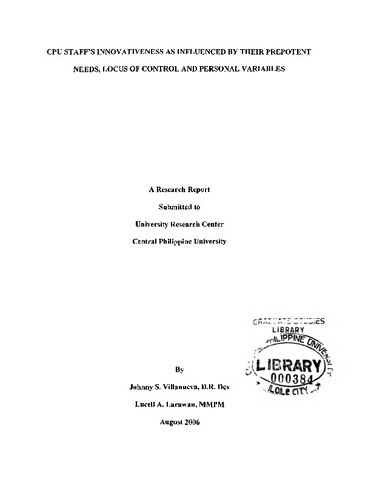CPU staff’s innovativeness as influenced by their prepotent needs, locus of control and personal variables
Abstract
This study measured the innovativeness level, prepotent need and locus of control of CPU staff members. It further tested the correlations between innovativeness and the independent variables which were prepotent need, locus of control and personal variables. This descriptive-correlational study surveyed 230 full-time CPU staff members assigned to the offices, laboratory and maintenance. Validated instruments were used to describe the major variables. For innovativeness level, an Innovativeness Questionnaire (IQ) by J.E. Bulk and R.D. O’Keefe was used. Hellriegel’s Prepotent Need Questionnaire (PNQ) was also used to determine the most powerful need of the respondents. The locus of control tendency of the CPU staff was determined using the instrument of Julian Rotter. Both descriptive and inferential statistics were used in the study. Means and frequency distributions were used for the descriptive part while Pearson’s r, Gamma and Cramer’s V were employed for the inferential part. Data were analyzed using SPSS Version 12. The CPU staff members of CPU were described as moderately innovative in their respective jobs. Their strongest need for self-actualization had a low correlation with innovativeness level. While the age and internal locus of control among the respondents were slightly correlated with innovativeness, the number of seminars attended, gender and educational attainment were not associated with this variable.
Paglalarawan
Abstract only
Mungkahing Sipi
Villanueva, J. S. & Larawan, L. A. (2006). CPU staff’s innovativeness as influenced by their prepotent needs, locus of control and personal variables (Research report). Jaro, Iloilo City, University Research Center, Central Philippine University.
Uri
Technical ReportMga Paksa
Mga keyword
Lokasyon ng Istante
GSL 650.072 V712
Pisikal na paglalarawan
viii, 41 leaves
Collections
- Research reports [167]
- Research reports [17]


